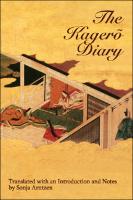The Kagero Diary
A Woman’s Autobiographical Text from Tenth-Century Japan
| dc.contributor.editor | Arntzen, Sonja | |
| dc.date.accessioned | 2020-09-23T15:13:15Z | |
| dc.date.available | 2020-09-23T15:13:15Z | |
| dc.date.issued | 2020 | |
| dc.identifier | ONIX_20200923_9780472901401_5 | |
| dc.identifier | OCN: 1184511058 | |
| dc.identifier.uri | https://library.oapen.org/handle/20.500.12657/41809 | |
| dc.description.abstract | Japan is the only country in the world where women writers laid the foundations of classical literature. The Kagero Diary commands our attention as the first extant work of that rich and brilliant tradition. The author, known to posterity as Michitsuna’s Mother, a member of the middle-ranking aristocracy of the Heian period (794–1185), wrote an account of 20 years of her life (from 954–74), and this autobiographical text now gives readers access to a woman’s experience of a thousand years ago. The diary centers on the author’s relationship with her husband, Fujiwara Kaneie, her kinsman from a more powerful and prestigious branch of the family than her own. Their marriage ended in divorce, and one of the author’s intentions seems to have been to write an anti-romance, one that could be subtitled, “I married the prince but we did not live happily ever after.” Yet, particularly in the first part of the diary, Michitsuna’s Mother is drawn to record those events and moments when the marriage did live up to a romantic ideal fostered by the Japanese tradition of love poetry. At the same time, she also seems to seek the freedom to live and write outside the romance myth and without a husband. Since the author was by inclination and talent a poet and lived in a time when poetry was a part of everyday social intercourse, her account of her life is shaped by a lyrical consciousness. The poems she records are crystalline moments of awareness that vividly recall the past. This new translation of the Kagero Diary conveys the long, fluid sentences, the complex polyphony of voices, and the floating temporality of the original. It also pays careful attention to the poems of the text, rendering as much as possible their complex imagery and open-ended quality. The translation is accompanied by running notes on facing pages and an introduction that places the work within the context of contemporary discussions regarding feminist literature and the genre of autobiography and provides detailed historical information and a description of the stylistic qualities of the text. | |
| dc.language | English | |
| dc.language | Japanese | |
| dc.relation.ispartofseries | Michigan Monograph Series in Japanese Studies | |
| dc.subject.classification | thema EDItEUR::J Society and Social Sciences::JH Sociology and anthropology | en_US |
| dc.subject.other | Sociology and anthropology | |
| dc.title | The Kagero Diary | |
| dc.title.alternative | A Woman’s Autobiographical Text from Tenth-Century Japan | |
| dc.type | book | |
| oapen.identifier.doi | 10.3998/mpub.18535 | |
| oapen.relation.isPublishedBy | e07ce9b5-7a46-4096-8f0c-bc1920e3d889 | |
| oapen.relation.isFundedBy | 0314e571-4102-4526-b014-3ed8f2d6750a | |
| oapen.relation.isFundedBy | 0cdc3d7c-5c59-49ed-9dba-ad641acd8fd1 | |
| oapen.imprint | U of M Center For Japanese Studies | |
| oapen.series.number | 19 | |
| oapen.pages | 433 | |
| oapen.place.publication | Ann Arbor | |
| oapen.grant.number | [grantnumber unknown] | |
| oapen.grant.number | [grantnumber unknown] | |
| peerreview.anonymity | Double-anonymised | |
| peerreview.id | d98bf225-990a-4ac4-acf4-fd7bf0dfb00c | |
| peerreview.open.review | No | |
| peerreview.publish.responsibility | Scientific or Editorial Board | |
| peerreview.review.decision | Yes | |
| peerreview.review.stage | Pre-publication | |
| peerreview.review.type | Full text | |
| peerreview.reviewer.type | External peer reviewer | |
| oapen.review.comments | The proposal was selected by the acquisitions editor who invited a full manuscript. The full manuscript was reviewed by two external readers using a double-blind process. Based on the acquisitions editor recommendation, the external reviews, and their own analysis, the Executive Committee (Editorial Board) of U-M Press approved the project for publication. |

